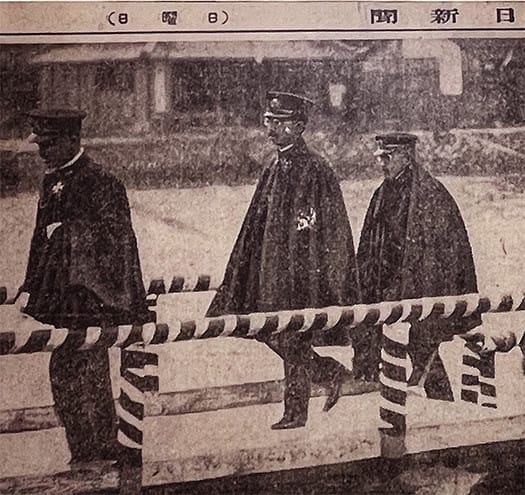

さて南方熊楠の自邸を6回ほどのブログ記事で見て来たのですが、そういう南方が日本史のスポットライトを浴びたのは、生物学に造詣を深められていた昭和天皇が、南方熊楠の学問追求を知って、紀州を訪れてかれから直接「進講」を受けられたいと希望されたこと。
昭和4年6月1日と日付のある「大阪毎日新聞」紙面では、天皇の紀州行幸は640年ぶりという見出しを振って1面記事として報道している。生物学者としての調査活動として田辺湾の神島に上陸され実地調査をされたのに対して、南方は神島でお迎えして参観ポイントを整理してご説明した後、天皇の「御座船」であった戦艦長門上で、ご進講を行った。
前記したけれど、南方熊楠はこれ以前に政府が進めていた全国の神社の統廃合に対して明確に反対をとなえて活動を行っていた。昭和天皇のこの行動は、皇国史観による行きすぎた行政対応を緩和させる方向に働いていったとされている。行政府の対応に対して明確にそれに異を唱えた人物に対して、その意見をリスペクトし進講を受けられた天皇の行動には興味を惹かれる。

平安期、多くの天皇退位後の上皇たちは「熊野詣」を繰り返していた。皇位としての行動制限から自由になった上皇たちは、はるか遠隔の地である熊野三山などを踏破してきていた。実際に「熊野古道」などを歩いてみれば、上皇たち自身も、みずから歩き巡っただろうことが想像される。なにかに突き動かされるかのようなそうした心理が民衆にも伝わって、蟻のようにという枕詞まで冠せられて、熊野詣は日本民族全般に及んでいった。空海や一遍上人など、多くの宗教者たちもこの紀州にリスペクトし、学ぶようになる。空海などは紀州の一帯・高野に根本道場の地を定め、みずからも「入定」している。
それぞれの行動にはある一貫性があって、南紀の自然風土の特異性に対しての特別な思いがそこに投影されているのだろうと思われる。たしかにわたし自身も、そういった心理は自らも体験することで、いわば体感的に納得させられている。火山列島地形が黒潮によって永い時間、強く影響されてきた自然観に、同じ日本人として共感を強く持つのだ。ネイティブ北海道人としての自分としても、この多くの人びとの行動について、深い納得と共感を持つ。
昭和天皇の行動には、そういった「民族性」が強く感じられる。そしてこの行動は、南方熊楠の人生とその事跡にとって、決定的なことがらになっていった。
English version⬇
The Emperor Showa's Landing on Kamijima and his Lecture on the Battleship Nagato Minakata Kumagusu-7
Nanki-Kumano welcomed the Emperor for the first time in 640 years since the Heian period. In the age when a battleship was considered as a throne ship, the Emperor showed his respect to Minakata Kumagusu as a biologist. ...
We have seen Minakata Kumagusu's residence in about 6 blog posts, but what brought Minakata into the spotlight of Japanese history was that Emperor Showa, who was deepening his knowledge of biology, was aware of Minakata Kumagusu's academic pursuits and wished to visit Kishu to receive a “lecture” directly from him.
The Osaka Mainichi Shimbun, dated June 1, 1929, carried a front-page article with the headline, “The Emperor's first visit to Kishu in 640 years. While the emperor landed on Kamijima Island in Tanabe Bay to conduct a field survey as a biologist, Minakata welcomed him on Kamijima Island, explained the points of interest, and then gave a lecture on board the battleship Nagato, the emperor's “throne ship”.
As mentioned above, Minakata Kumagusu had been clearly opposed to the consolidation of shrines in Japan, which had been promoted by the government. It is said that this action of the Showa Emperor worked in the direction of mitigating the excessive administrative response based on the imperialist view of history. It is interesting to note that the Emperor respected the opinions of those who clearly disagreed with the executive branch's response and accepted their lectures.
During the Heian period, many emperors after their abdication repeatedly made pilgrimages to Kumano. Freed from the restrictions of the imperial throne, these emperors had traversed the Kumano Sanzan (three mountains of Kumano) and other far-flung places. In fact, if one actually walks along the “Kumano Kodo,” one can imagine that the emperors themselves must have walked the route themselves. The people of Kumano were also moved by such a spirit, and the pilgrimage to Kumano, which was even referred to as “like ants,” spread throughout the Japanese people. Many religious figures, such as Kukai and Ippen Shonin, came to respect and learn from Kishu. Kukai, for example, established his fundamental dojo in Koya, an area in Kishu, and himself “entered the Buddhist monastery” there.
There is a certain consistency in the actions of each of them, and it seems to me that their special feelings toward the uniqueness of the natural climate of Nanki are reflected in their actions. Indeed, I myself have experienced this kind of mentality myself, and I am convinced of it from first-hand experience. As a Japanese, I strongly sympathize with the view of nature that has been strongly influenced by the Kuroshio Current for a long time on the volcanic island chain. As a native Hokkaidoian, I also have a deep understanding and sympathy for the actions of many of these people.
In the actions of Emperor Showa, I strongly feel such “ethnicity. And this action became a decisive factor in the life and legacy of Minakata Kumagusu.

















